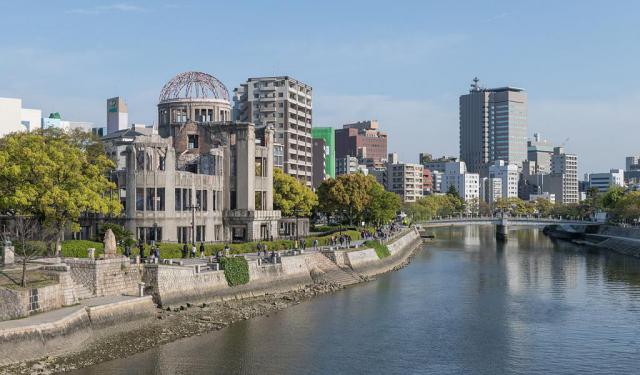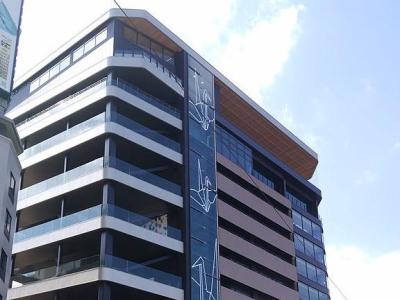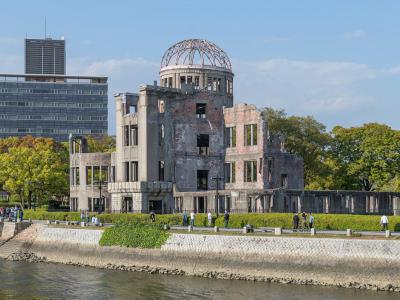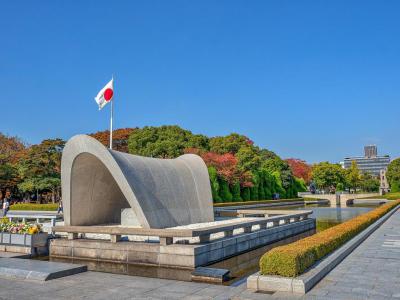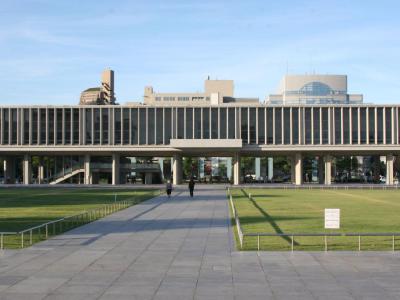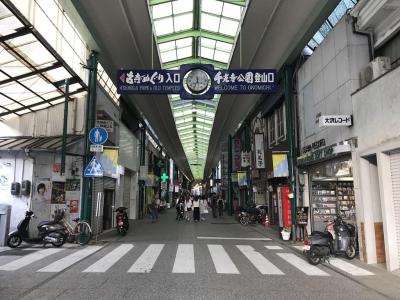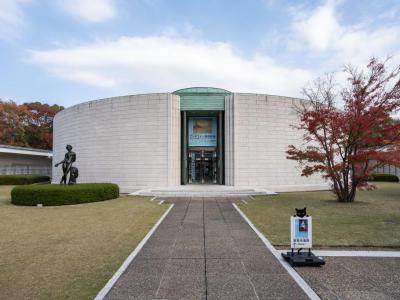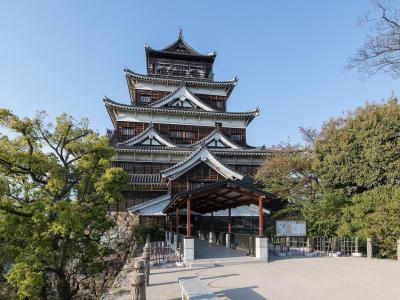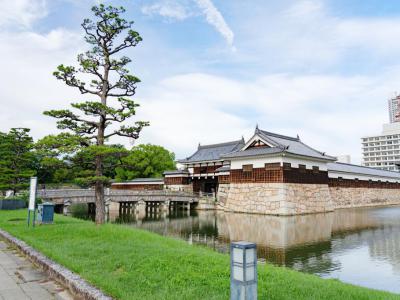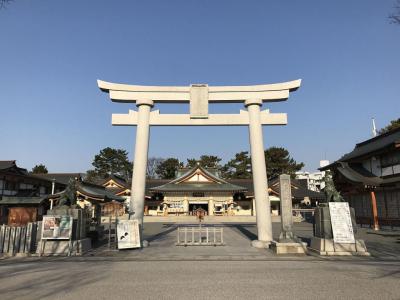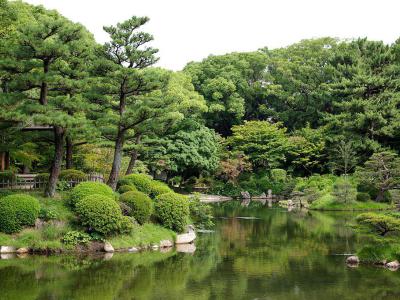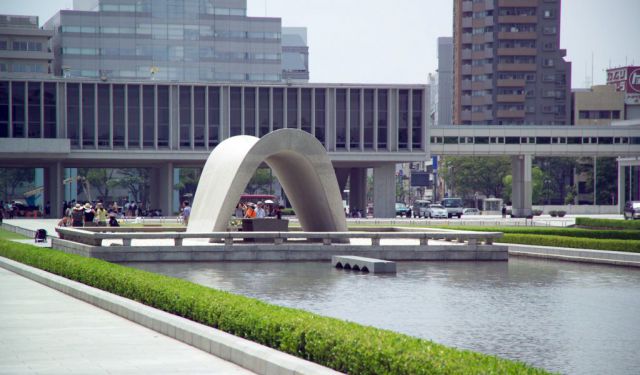Hiroshima Introduction Walking Tour (Self Guided), Hiroshima
Tucked away within the contours of Japan's southwestern expanse, the green and picturesque city of Hiroshima emerges as a profound testament to history's arc and an unwavering beacon of hope for a world united in harmony.
Composed of two kanji characters: "hiro", which means "wide" or "broad," and "shima", which means "island," the city's name refers to its location on the broad delta formed by the Ota River and invokes both expansiveness and insularity, emanating an atmosphere of tranquility fused with renewal.
Hiroshima's history spans epochs, starting from its inception in the 16th century as a castle town established by the feudal lord Mōri Terumoto. The majestic "Carp" Castle, an edifice resonating with feudal legacy, houses a museum that breathes life into bygone eras. Adjacent to it, the verdant oasis of Hiroshima Castle Park is alive with serenity, enticing contemplative strolls.
During the Edo period, between the 17th and 19th centuries, Hiroshima transformed into a vibrant center of trade and culture. However, the city's trajectory changed dramatically during World War II, on the fateful day of August 6, 1945, when it became the target of the first atomic bomb attack that etched Hiroshima forever into the annals of global memory.
A singular flash of the cataclysmic force gave rise to the Atomic Bomb Dome, the poignant skeletal silhouette of which today serves as a somber reminder of humanity's gravest capabilities for destruction and a symbol of the phoenix-like resurgence that followed.
Central to Hiroshima's essence is the Peace Memorial Park, imbued with the aspiration for lasting accord. Within its embrace, the Hiroshima Peace Memorial Museum stands as a repository of heart-rending stories and touching artifacts, offering an unflinching look into Hiroshima's darkest hours.
The Gokoku Shrine, an emblem of sacred reverence, pays homage to the spirits of those who died in service to their country, while the Shukkei-en Garden, a meticulously landscaped masterpiece, unveils nature's tranquility in miniature form.
At the apex of Hiroshima's aspirations, the Orizuru Tower reaches skyward as an emblem of the timeless art of origami ("orizuru" literally means a folded paper crane). This modern landmark offers panoramic vistas that beckon reflection upon Hiroshima's enduring journey – from shadows to radiance, from devastation to aspiration, and from conflict to peace.
As you immerse yourself in Hiroshima's tapestry, seize the inspiration it offers to cultivate a world where unity and understanding triumph over discord, ensuring that the lessons of Hiroshima are duly remembered through the ages.
Composed of two kanji characters: "hiro", which means "wide" or "broad," and "shima", which means "island," the city's name refers to its location on the broad delta formed by the Ota River and invokes both expansiveness and insularity, emanating an atmosphere of tranquility fused with renewal.
Hiroshima's history spans epochs, starting from its inception in the 16th century as a castle town established by the feudal lord Mōri Terumoto. The majestic "Carp" Castle, an edifice resonating with feudal legacy, houses a museum that breathes life into bygone eras. Adjacent to it, the verdant oasis of Hiroshima Castle Park is alive with serenity, enticing contemplative strolls.
During the Edo period, between the 17th and 19th centuries, Hiroshima transformed into a vibrant center of trade and culture. However, the city's trajectory changed dramatically during World War II, on the fateful day of August 6, 1945, when it became the target of the first atomic bomb attack that etched Hiroshima forever into the annals of global memory.
A singular flash of the cataclysmic force gave rise to the Atomic Bomb Dome, the poignant skeletal silhouette of which today serves as a somber reminder of humanity's gravest capabilities for destruction and a symbol of the phoenix-like resurgence that followed.
Central to Hiroshima's essence is the Peace Memorial Park, imbued with the aspiration for lasting accord. Within its embrace, the Hiroshima Peace Memorial Museum stands as a repository of heart-rending stories and touching artifacts, offering an unflinching look into Hiroshima's darkest hours.
The Gokoku Shrine, an emblem of sacred reverence, pays homage to the spirits of those who died in service to their country, while the Shukkei-en Garden, a meticulously landscaped masterpiece, unveils nature's tranquility in miniature form.
At the apex of Hiroshima's aspirations, the Orizuru Tower reaches skyward as an emblem of the timeless art of origami ("orizuru" literally means a folded paper crane). This modern landmark offers panoramic vistas that beckon reflection upon Hiroshima's enduring journey – from shadows to radiance, from devastation to aspiration, and from conflict to peace.
As you immerse yourself in Hiroshima's tapestry, seize the inspiration it offers to cultivate a world where unity and understanding triumph over discord, ensuring that the lessons of Hiroshima are duly remembered through the ages.
How it works: Download the app "GPSmyCity: Walks in 1K+ Cities" from Apple App Store or Google Play Store to your mobile phone or tablet. The app turns your mobile device into a personal tour guide and its built-in GPS navigation functions guide you from one tour stop to next. The app works offline, so no data plan is needed when traveling abroad.
Hiroshima Introduction Walking Tour Map
Guide Name: Hiroshima Introduction Walking Tour
Guide Location: Japan » Hiroshima (See other walking tours in Hiroshima)
Guide Type: Self-guided Walking Tour (Sightseeing)
# of Attractions: 10
Tour Duration: 2 Hour(s)
Travel Distance: 3.8 Km or 2.4 Miles
Author: DanaOffice
Sight(s) Featured in This Guide:
Guide Location: Japan » Hiroshima (See other walking tours in Hiroshima)
Guide Type: Self-guided Walking Tour (Sightseeing)
# of Attractions: 10
Tour Duration: 2 Hour(s)
Travel Distance: 3.8 Km or 2.4 Miles
Author: DanaOffice
Sight(s) Featured in This Guide:
- Hiroshima Orizuru Tower
- Atomic Bomb Dome
- Hiroshima Peace Memorial Park
- Hiroshima Peace Memorial Museum
- Hondori Shopping Arcade
- Hiroshima Museum of Art
- Hiroshima "Carp" Castle
- Hiroshima Castle Park
- Gokoku Shrine
- Shukkei-en Garden
1) Hiroshima Orizuru Tower
Hiroshima Orizuru Tower is a significant landmark that offers visitors a unique perspective of the city. Officially opened in September 2016, this 50-meter-tall tower stands out among the few tall buildings surrounding the Peace Memorial Park and provides a captivating view of the surroundings, including a lesser-known aerial view of the A-Bomb Dome.
The tower encompasses various areas for visitors to explore. At street level, there is a cozy café and a souvenir select shop where visitors can relax and browse. The top floor features an observation deck, allowing guests to admire the panoramic vistas while feeling the gentle breeze. To reach the top, visitors can either take the elevator or choose to ascend via a spiraling walkway, offering a chance to appreciate the artwork that tells the story of a fictional family and their life experiences.
On the 12th floor, just below the observation deck, lies the interactive multimedia zone. This open-plan area provides a stunning view through large glass panels, protecting visitors from the elements while allowing them to observe the actual ground zero where the atomic bomb detonated approximately 600 meters above ground. From this vantage point, one can also see the A-Bomb Dome and the Hiroshima Peace Memorial Museum in the distance.
Within the multimedia zone, visitors can engage with interactive displays suitable for all ages, immersing themselves in the history and future of Hiroshima. A timelapse feature showcases the city's transformation since the war and envisions its potential evolution over the next hundred years.
The tower encompasses various areas for visitors to explore. At street level, there is a cozy café and a souvenir select shop where visitors can relax and browse. The top floor features an observation deck, allowing guests to admire the panoramic vistas while feeling the gentle breeze. To reach the top, visitors can either take the elevator or choose to ascend via a spiraling walkway, offering a chance to appreciate the artwork that tells the story of a fictional family and their life experiences.
On the 12th floor, just below the observation deck, lies the interactive multimedia zone. This open-plan area provides a stunning view through large glass panels, protecting visitors from the elements while allowing them to observe the actual ground zero where the atomic bomb detonated approximately 600 meters above ground. From this vantage point, one can also see the A-Bomb Dome and the Hiroshima Peace Memorial Museum in the distance.
Within the multimedia zone, visitors can engage with interactive displays suitable for all ages, immersing themselves in the history and future of Hiroshima. A timelapse feature showcases the city's transformation since the war and envisions its potential evolution over the next hundred years.
2) Atomic Bomb Dome (must see)
The Atomic Bomb Dome, also known as the Hiroshima Peace Memorial, stands as a poignant symbol of remembrance and peace in Hiroshima, Japan. Located within the Hiroshima Peace Memorial Park, this iconic structure was designated a UNESCO World Heritage Site in 1996. The building serves as a solemn memorial to the thousands of lives lost in the devastating atomic bombing of Hiroshima during World War II.
On August 6, 1945, at 8:15 am, the first nuclear bomb used in warfare detonated almost directly above the Atomic Bomb Dome. Originally, the "T"-shaped Aioi Bridge was the intended target, but the bomb missed slightly, and the dome became the center of the blast. Remarkably, the actual center of the explosion was 490 feet (150 meters) away and 1,968 feet (600 meters) above the ground. Despite being located at the epicenter of the blast, the dome's skeletal remains withstood the destructive force, making it an enduring symbol of resilience and hope amid tragedy.
In the aftermath of the bombing, as Hiroshima began to rebuild, the fate of the Atomic Bomb Dome became a matter of controversy. Some locals wanted it torn down, considering it a painful reminder of the past. However, others passionately advocated for its preservation as a somber testament to the horrors of nuclear warfare and a plea for peace.
In 1966, after much debate, Hiroshima City made the decision to preserve the A-bomb Dome indefinitely. The initiative to conserve the structure was supported by both local and international efforts, seeking funds to ensure its preservation. To date, the Atomic Bomb Dome has undergone two preservation projects to maintain its historical integrity and ensure its lasting legacy.
On August 6, 1945, at 8:15 am, the first nuclear bomb used in warfare detonated almost directly above the Atomic Bomb Dome. Originally, the "T"-shaped Aioi Bridge was the intended target, but the bomb missed slightly, and the dome became the center of the blast. Remarkably, the actual center of the explosion was 490 feet (150 meters) away and 1,968 feet (600 meters) above the ground. Despite being located at the epicenter of the blast, the dome's skeletal remains withstood the destructive force, making it an enduring symbol of resilience and hope amid tragedy.
In the aftermath of the bombing, as Hiroshima began to rebuild, the fate of the Atomic Bomb Dome became a matter of controversy. Some locals wanted it torn down, considering it a painful reminder of the past. However, others passionately advocated for its preservation as a somber testament to the horrors of nuclear warfare and a plea for peace.
In 1966, after much debate, Hiroshima City made the decision to preserve the A-bomb Dome indefinitely. The initiative to conserve the structure was supported by both local and international efforts, seeking funds to ensure its preservation. To date, the Atomic Bomb Dome has undergone two preservation projects to maintain its historical integrity and ensure its lasting legacy.
3) Hiroshima Peace Memorial Park (must see)
Hiroshima Peace Memorial Park stands as a profound testament to the enduring legacy of Hiroshima, as the first city in the world to suffer the devastating impact of a nuclear attack during World War II. The park is a dedicated space that pays homage to the memories of the direct and indirect victims of the atomic bomb, which claimed the lives of as many as 140,000 people. Located in what was once the bustling downtown commercial and residential district of the city, the park was built on the open field that was created by the destructive explosion.
Today, Hiroshima Peace Memorial Park encompasses a range of memorials, monuments, museums, and lecture halls, attracting over a million visitors annually from all corners of the globe. The park serves as a poignant reminder of the atrocities of nuclear warfare and the devastating consequences it can unleash upon humanity.
More than just a place of mourning, Hiroshima Peace Memorial Park serves a broader purpose: to serve as a potent symbol for peace advocacy worldwide. Visitors to the park are invited to contemplate the immense suffering and loss caused by the atomic bomb, and to reflect on the value of life and the importance of cherishing peace. The park's museums and exhibitions provide in-depth insights into the events surrounding the atomic bombing, leaving visitors with a profound sense of responsibility to work towards a world where such devastation is never repeated.
Today, Hiroshima Peace Memorial Park encompasses a range of memorials, monuments, museums, and lecture halls, attracting over a million visitors annually from all corners of the globe. The park serves as a poignant reminder of the atrocities of nuclear warfare and the devastating consequences it can unleash upon humanity.
More than just a place of mourning, Hiroshima Peace Memorial Park serves a broader purpose: to serve as a potent symbol for peace advocacy worldwide. Visitors to the park are invited to contemplate the immense suffering and loss caused by the atomic bomb, and to reflect on the value of life and the importance of cherishing peace. The park's museums and exhibitions provide in-depth insights into the events surrounding the atomic bombing, leaving visitors with a profound sense of responsibility to work towards a world where such devastation is never repeated.
4) Hiroshima Peace Memorial Museum (must see)
The Hiroshima Peace Memorial Museum stands as a powerful testament to the devastating impact of the atomic bomb and serves as a poignant reminder of the urgent need for peace and nuclear disarmament. Established in 1955, the museum's mission is to communicate the reality of the damage caused by the atomic bomb to people worldwide and to advocate for the abolition of nuclear weapons and the attainment of lasting global peace, at the very core of Hiroshima's essence.
On the fateful morning of August 6, 1945, at 8:15 am, Hiroshima became the first city in the world to suffer the catastrophic consequences of an atomic bomb. The unimaginable devastation resulted in the destruction of most of the city and the loss of countless lives. Those who miraculously survived the bombing endured severe physical and psychological trauma, with many A-bomb survivors continuing to suffer to this day.
The Hiroshima Peace Memorial Museum collects and displays an array of poignant photographs and artifacts, showcasing the grim remains of the A-bomb survivors and the devastation caused by the bomb's explosion. The exhibits also chronicle the history of Hiroshima before and after the bombing and offer insights into the broader context of the nuclear age. Through its thought-provoking displays, the museum offers visitors a deep understanding of the profound consequences of nuclear warfare and the impact on human lives.
Additionally, the museum plays an active role in preserving the stories of A-bomb survivors by organizing lectures where survivors share their experiences. These first-hand accounts serve as powerful testimonials, fostering empathy and understanding among visitors, and emphasizing the importance of peace and reconciliation.
On the fateful morning of August 6, 1945, at 8:15 am, Hiroshima became the first city in the world to suffer the catastrophic consequences of an atomic bomb. The unimaginable devastation resulted in the destruction of most of the city and the loss of countless lives. Those who miraculously survived the bombing endured severe physical and psychological trauma, with many A-bomb survivors continuing to suffer to this day.
The Hiroshima Peace Memorial Museum collects and displays an array of poignant photographs and artifacts, showcasing the grim remains of the A-bomb survivors and the devastation caused by the bomb's explosion. The exhibits also chronicle the history of Hiroshima before and after the bombing and offer insights into the broader context of the nuclear age. Through its thought-provoking displays, the museum offers visitors a deep understanding of the profound consequences of nuclear warfare and the impact on human lives.
Additionally, the museum plays an active role in preserving the stories of A-bomb survivors by organizing lectures where survivors share their experiences. These first-hand accounts serve as powerful testimonials, fostering empathy and understanding among visitors, and emphasizing the importance of peace and reconciliation.
5) Hondori Shopping Arcade
Hondori Shopping Arcade in Hiroshima, Japan, is a vibrant and bustling shopping district located in the heart of the city's downtown area. This pedestrian arcade street, known as a "shotengai," offers an exciting shopping experience with a diverse range of stores and entertainment options.
For avid shoppers, Hondori Street is a paradise, boasting an array of shops that cater to various tastes and interests. From fashionable clothing stores and trendy boutiques to cafes and restaurants, visitors can find a wide selection of goods and delicacies to satisfy their cravings. Anime enthusiasts can explore specialty shops dedicated to their favorite characters and series, while gaming enthusiasts can enjoy the excitement of arcades. Purikura parlors offer the chance to take fun and customizable photo stickers, adding a touch of Japanese pop culture to the experience.
The street comes alive with karaoke bars, where visitors can showcase their singing talents and enjoy a lively atmosphere. With so much to explore and discover, Hondori Street is a popular choice for both locals and tourists looking to indulge in a day of shopping and entertainment.
The covered walkway of the arcade provides a pleasant and convenient shopping environment, protecting shoppers from the elements. Whether it's rain or shine, visitors can leisurely explore the shops and take their time finding the perfect souvenirs and treasures to bring back home.
For avid shoppers, Hondori Street is a paradise, boasting an array of shops that cater to various tastes and interests. From fashionable clothing stores and trendy boutiques to cafes and restaurants, visitors can find a wide selection of goods and delicacies to satisfy their cravings. Anime enthusiasts can explore specialty shops dedicated to their favorite characters and series, while gaming enthusiasts can enjoy the excitement of arcades. Purikura parlors offer the chance to take fun and customizable photo stickers, adding a touch of Japanese pop culture to the experience.
The street comes alive with karaoke bars, where visitors can showcase their singing talents and enjoy a lively atmosphere. With so much to explore and discover, Hondori Street is a popular choice for both locals and tourists looking to indulge in a day of shopping and entertainment.
The covered walkway of the arcade provides a pleasant and convenient shopping environment, protecting shoppers from the elements. Whether it's rain or shine, visitors can leisurely explore the shops and take their time finding the perfect souvenirs and treasures to bring back home.
6) Hiroshima Museum of Art
The Hiroshima Museum of Art is a haven of artistic expression and a testament to the enduring pursuit of love and peace. Its theme, "For love and peace," embodies the museum's commitment to honoring the victims of the atomic bomb and praying for their eternal rest and peace.
Within its walls, the museum showcases a diverse collection of artworks from around the world, spanning from the Romantics of the mid-19th century to the School of Paris. It also houses a remarkable collection of modern Japanese art from the Meiji era to the present. Notably, the museum boasts an outstanding array of French Impressionist works, including masterpieces by renowned artists such as Cezanne, Manet, Renoir, and Van Gogh.
The front yard of the museum is graced with the presence of a Maronien tree, a generous donation from Picasso's son, adding an extra layer of artistic significance to the museum's ambiance.
The Hiroshima Museum of Art is not merely a space for art enthusiasts and scholars; it warmly welcomes visitors of all ages and backgrounds. It offers numerous special exhibitions that cater to everyone, from children to adults, making it an inviting destination for those new to the world of art museums.
In addition to being a center of artistic enrichment, the museum serves as a place of solace and relaxation for the citizens of Hiroshima. Its inviting cafes allow visitors to savor a cup of tea while immersing themselves in the serenity of the beautiful garden.
Within its walls, the museum showcases a diverse collection of artworks from around the world, spanning from the Romantics of the mid-19th century to the School of Paris. It also houses a remarkable collection of modern Japanese art from the Meiji era to the present. Notably, the museum boasts an outstanding array of French Impressionist works, including masterpieces by renowned artists such as Cezanne, Manet, Renoir, and Van Gogh.
The front yard of the museum is graced with the presence of a Maronien tree, a generous donation from Picasso's son, adding an extra layer of artistic significance to the museum's ambiance.
The Hiroshima Museum of Art is not merely a space for art enthusiasts and scholars; it warmly welcomes visitors of all ages and backgrounds. It offers numerous special exhibitions that cater to everyone, from children to adults, making it an inviting destination for those new to the world of art museums.
In addition to being a center of artistic enrichment, the museum serves as a place of solace and relaxation for the citizens of Hiroshima. Its inviting cafes allow visitors to savor a cup of tea while immersing themselves in the serenity of the beautiful garden.
7) Hiroshima "Carp" Castle (must see)
Hiroshima "Carp" Castle is a historical landmark with a captivating and tragic history. Originally constructed in the 1590s, the castle stood tall as a symbol of power and authority in the region. Its architectural style exemplified a hirajiro, or flatlands, castle, a characteristic design that adapted well to the surrounding plains.
Throughout its existence, Hiroshima Castle played a crucial role in the region's history. It boasted three concentric moats, fortifying the castle's defenses and adding an aura of grandeur to its appearance. To the west, the Otagawa River, now known as the Hongawa, provided a natural barrier that further enhanced the castle's security.
However, the castle's fate would change dramatically on August 6, 1945, during World War II. Tragically, Hiroshima was subjected to one of the most devastating events in human history - the atomic bombing by the United States. The castle, a prominent symbol of the city, was obliterated, leaving behind only ruins and sorrow.
In the aftermath of the destruction, a determined effort was made to rebuild Hiroshima and restore its heritage. A replica of the original Hiroshima Castle was constructed in 1958 as a testament to the city's resilience and a tribute to its past. Although it couldn't fully replace the historical significance of the original, the reconstruction served as a powerful reminder of the city's history prior to the catastrophic event.
Today, the rebuilt Hiroshima Castle serves as a museum, chronicling the history of Hiroshima before the devastation of World War II. Inside its walls, visitors can immerse themselves in the rich cultural heritage of the region, understanding the historical context that shaped Hiroshima's identity.
Throughout its existence, Hiroshima Castle played a crucial role in the region's history. It boasted three concentric moats, fortifying the castle's defenses and adding an aura of grandeur to its appearance. To the west, the Otagawa River, now known as the Hongawa, provided a natural barrier that further enhanced the castle's security.
However, the castle's fate would change dramatically on August 6, 1945, during World War II. Tragically, Hiroshima was subjected to one of the most devastating events in human history - the atomic bombing by the United States. The castle, a prominent symbol of the city, was obliterated, leaving behind only ruins and sorrow.
In the aftermath of the destruction, a determined effort was made to rebuild Hiroshima and restore its heritage. A replica of the original Hiroshima Castle was constructed in 1958 as a testament to the city's resilience and a tribute to its past. Although it couldn't fully replace the historical significance of the original, the reconstruction served as a powerful reminder of the city's history prior to the catastrophic event.
Today, the rebuilt Hiroshima Castle serves as a museum, chronicling the history of Hiroshima before the devastation of World War II. Inside its walls, visitors can immerse themselves in the rich cultural heritage of the region, understanding the historical context that shaped Hiroshima's identity.
8) Hiroshima Castle Park
Hiroshima Castle Park, also known as Carp Castle Park, is a picturesque and historically significant green space situated in the heart of Hiroshima. The park's history is deeply intertwined with that of Hiroshima Castle, which originally stood here.
One of the distinctive features of Hiroshima Castle Park is the wide ditch that surrounds the castle complex, forming a natural barrier. This water-filled moat not only enhances the aesthetic appeal of the park but also serves as a subtle reminder of the historical significance of the castle's defense system. Visitors can enjoy leisurely strolls along the edges of the moat or rest on nearby benches, basking in the serenity of the surroundings.
Today, Hiroshima Castle Park stands as a harmonious blend of historical and contemporary elements. The lush greenery, meticulously maintained gardens, and traditional architecture of the castle provide a captivating juxtaposition against the modern cityscape that has grown around it.
Within the park's boundaries, visitors can explore various attractions and cultural sites. The reconstructed Hiroshima Castle stands as the park's centerpiece, offering insights into the city's past and serving as a museum that narrates the history of Hiroshima prior to World War II.
Moreover, the park provides an ideal setting for local events, cultural festivals, and recreational activities, further integrating itself into the fabric of the community.
One of the distinctive features of Hiroshima Castle Park is the wide ditch that surrounds the castle complex, forming a natural barrier. This water-filled moat not only enhances the aesthetic appeal of the park but also serves as a subtle reminder of the historical significance of the castle's defense system. Visitors can enjoy leisurely strolls along the edges of the moat or rest on nearby benches, basking in the serenity of the surroundings.
Today, Hiroshima Castle Park stands as a harmonious blend of historical and contemporary elements. The lush greenery, meticulously maintained gardens, and traditional architecture of the castle provide a captivating juxtaposition against the modern cityscape that has grown around it.
Within the park's boundaries, visitors can explore various attractions and cultural sites. The reconstructed Hiroshima Castle stands as the park's centerpiece, offering insights into the city's past and serving as a museum that narrates the history of Hiroshima prior to World War II.
Moreover, the park provides an ideal setting for local events, cultural festivals, and recreational activities, further integrating itself into the fabric of the community.
9) Gokoku Shrine
Gokoku Shrine is a place of deep historical and cultural significance. Its origins can be traced back to the early days of the Meiji period, as it was originally established in 1868 in Futabanosato Hiroshima. The shrine was built to honor and mourn the victims of the Boshin War, a pivotal conflict that marked the end of the samurai era and the beginning of Japan's modernization.
In 1934, the shrine underwent a significant change as it was dismantled and relocated to its current location, where the Hiroshima Municipal Stadium now stands. This move was followed by a renaming, and the shrine became known as the Hiroshima Gokoku Shrine in 1939. Its name "Gokoku" signifies its role as a protector of the nation and its people.
Tragically, the Hiroshima Gokoku Shrine fell victim to the horrors of the atomic bombing in 1945. The devastating impact of the bombing destroyed the shrine and left behind a landscape of destruction and sorrow.
Despite the immense challenges faced by the city in the aftermath of the bombing, the citizens of Hiroshima remained determined to rebuild and preserve their cultural heritage. With the aid of generous donations from the local community, the Hiroshima Gokoku Shrine was reconstructed within the grounds of Hiroshima Castle in 1965. This momentous effort not only restored the shrine to its former glory but also served as a symbol of hope and resilience for the city and its people.
Today, the Hiroshima Gokoku Shrine stands as a cherished place of worship and reflection. It holds a special place in the hearts of the residents, making it one of the most popular sites for celebrating important traditional ceremonies such as Hatsumode, the first shrine visit of the New Year, and Shichi-Go-San, a celebration of children's growth and well-being.
In 1934, the shrine underwent a significant change as it was dismantled and relocated to its current location, where the Hiroshima Municipal Stadium now stands. This move was followed by a renaming, and the shrine became known as the Hiroshima Gokoku Shrine in 1939. Its name "Gokoku" signifies its role as a protector of the nation and its people.
Tragically, the Hiroshima Gokoku Shrine fell victim to the horrors of the atomic bombing in 1945. The devastating impact of the bombing destroyed the shrine and left behind a landscape of destruction and sorrow.
Despite the immense challenges faced by the city in the aftermath of the bombing, the citizens of Hiroshima remained determined to rebuild and preserve their cultural heritage. With the aid of generous donations from the local community, the Hiroshima Gokoku Shrine was reconstructed within the grounds of Hiroshima Castle in 1965. This momentous effort not only restored the shrine to its former glory but also served as a symbol of hope and resilience for the city and its people.
Today, the Hiroshima Gokoku Shrine stands as a cherished place of worship and reflection. It holds a special place in the hearts of the residents, making it one of the most popular sites for celebrating important traditional ceremonies such as Hatsumode, the first shrine visit of the New Year, and Shichi-Go-San, a celebration of children's growth and well-being.
10) Shukkei-en Garden (must see)
Shukkei-en Garden is a historic and exquisite Japanese garden with a rich and fascinating history. Its construction began in 1620 during the Edo period, under the orders of Asano Nagaakira, the daimyo (feudal lord) of Hiroshima Han.
To create this magnificent garden, the seventh lord of the Han summoned a skilled expert in Japanese garden construction from Kyoto. With their expertise, Shukkei-en was meticulously designed and crafted to embody the essence of traditional Japanese landscaping and aesthetics.
During the Meiji period, the garden served as a tranquil retreat and villa for the Asano family. However, its significance expanded when Emperor Meiji's Imperial General Headquarters were relocated to Hiroshima, and the emperor briefly stayed at the villa. Following this historical event, the garden was opened to the public, allowing visitors to appreciate its serene beauty and harmonious design.
The garden's journey took a significant turn during World War II when Hiroshima became the target of the first atomic bomb used in warfare. Shukkei-en Garden, unfortunately, lay in close proximity to Ground Zero of the nuclear attack. The bombing inflicted extensive damage on the garden, devastating its carefully curated landscapes and structures.
In the aftermath of the bombing, the garden served as a place of refuge for victims of the war, providing solace amidst the chaos and destruction. Despite the challenges faced during this dark period, the resilience of the people and their dedication to preserving their cultural heritage allowed for the rehabilitation and restoration of Shukkei-en Garden.
Following renovations and reconstruction efforts, the garden triumphantly reopened its gates to the public in 1951, presenting once again a haven of tranquility and beauty amidst the bustling city of Hiroshima. The carefully tended landscapes, picturesque ponds, graceful bridges, and traditional structures all contribute to the charm and allure of Shukkei-en.
Today, visitors from all over the world can experience the profound historical significance and the serene ambiance that envelopes Shukkei-en Garden. It stands as a testament to the enduring spirit of the Japanese people, symbolizing their ability to rebuild and heal even after facing immense adversity.
To create this magnificent garden, the seventh lord of the Han summoned a skilled expert in Japanese garden construction from Kyoto. With their expertise, Shukkei-en was meticulously designed and crafted to embody the essence of traditional Japanese landscaping and aesthetics.
During the Meiji period, the garden served as a tranquil retreat and villa for the Asano family. However, its significance expanded when Emperor Meiji's Imperial General Headquarters were relocated to Hiroshima, and the emperor briefly stayed at the villa. Following this historical event, the garden was opened to the public, allowing visitors to appreciate its serene beauty and harmonious design.
The garden's journey took a significant turn during World War II when Hiroshima became the target of the first atomic bomb used in warfare. Shukkei-en Garden, unfortunately, lay in close proximity to Ground Zero of the nuclear attack. The bombing inflicted extensive damage on the garden, devastating its carefully curated landscapes and structures.
In the aftermath of the bombing, the garden served as a place of refuge for victims of the war, providing solace amidst the chaos and destruction. Despite the challenges faced during this dark period, the resilience of the people and their dedication to preserving their cultural heritage allowed for the rehabilitation and restoration of Shukkei-en Garden.
Following renovations and reconstruction efforts, the garden triumphantly reopened its gates to the public in 1951, presenting once again a haven of tranquility and beauty amidst the bustling city of Hiroshima. The carefully tended landscapes, picturesque ponds, graceful bridges, and traditional structures all contribute to the charm and allure of Shukkei-en.
Today, visitors from all over the world can experience the profound historical significance and the serene ambiance that envelopes Shukkei-en Garden. It stands as a testament to the enduring spirit of the Japanese people, symbolizing their ability to rebuild and heal even after facing immense adversity.
Walking Tours in Hiroshima, Japan
Create Your Own Walk in Hiroshima
Creating your own self-guided walk in Hiroshima is easy and fun. Choose the city attractions that you want to see and a walk route map will be created just for you. You can even set your hotel as the start point of the walk.
Hiroshima Peace Memorial Tour
Hiroshima Peace Memorial Park stands as a solemn testament to one of the darkest chapters in human history. This park is a haunting reminder of the catastrophic impact of nuclear warfare during World War II. Its grounds, marked by heart-wrenching attractions, bear witness to the immense suffering and loss that occurred on August 6, 1945.
Within this place of sorrow, the attractions etch the... view more
Tour Duration: 1 Hour(s)
Travel Distance: 1.1 Km or 0.7 Miles
Within this place of sorrow, the attractions etch the... view more
Tour Duration: 1 Hour(s)
Travel Distance: 1.1 Km or 0.7 Miles
The Most Popular Cities
/ view all
